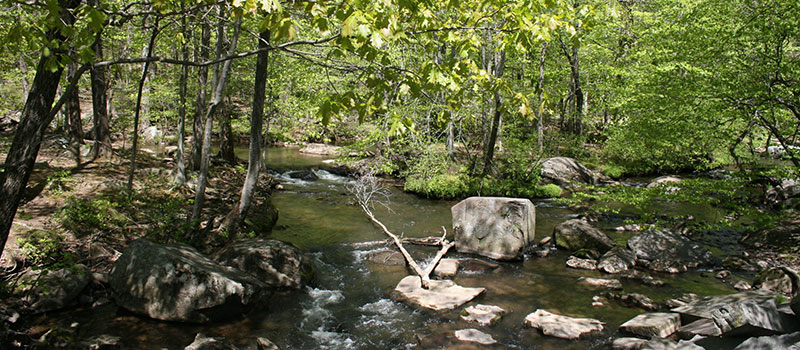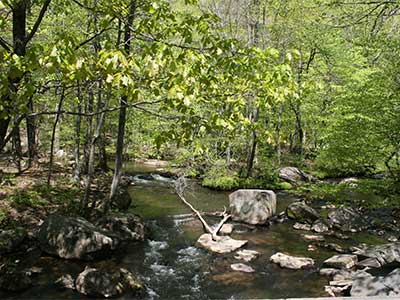Stream in Chester County
How it Works
Chester County continues to grow and attract new development in our communities, the overall amount of impervious surface is increasing, along with urban and agricultural runoff, road salts, pet waste, and sources of pollutants. While local municipal ordinances regulate land use activities, federal and state regulations establish minimum water quality standards that must be met regardless of what activities or development takes place on the lands near our waterways.
Generally, there are two major factors which impact water quality regulations for a particular waterbody: its designated use(s) and whether it meets those standards. These factors are governed by Pennsylvania's Chapter 93 "Water Quality Standards," which has roots in both the Federal Clean Water Act administered by the U.S. Environmental Protection Agency (EPA) and the PA Clean Streams Law administered by the Pennsylvania Department of Environmental Protection (PADEP).
Designated Uses
In Pennsylvania, there are four primary "designated use" categories for waterways:
- Aquatic life (cold water fisheries, warm water fisheries, migratory fisheries, trout stocking fisheries)
- Water supply (potable water supply, industrial use, livestock water supply, wildlife water supply, irrigation)
- Recreation (boating, fishing, water contact sports, aesthetics)
- Fish consumption
All waterways are designated at a minimum as warm water fisheries for aquatic life uses, and for all uses under the water supply, recreation, and fish consumption categories. On a case-by-case basis, streams may be classified as cold water fisheries or trout stocking fisheries based on local conditions.
In addition to these four categories, certain waterbodies that meet specific criteria may be labeled as Special Protection waters and receive an "Exceptional Value" or "High Quality" designation.
- High Quality (HQ) streams are those which have been identified as exceeding the standards for water chemistry and that support high quality aquatic communities.
- Exceptional Value (EV) streams share the same traits as HQ streams, and meet additional criteria related to ecological significance.
Special Protection waters are afforded more stringent protections under the law through the State's antidegradation policy. This policy strictly limits activities that may negatively impact water quality in streams that currently meet or exceed state standards.
Each designated use has associated water quality standards that must be met in order for the use to be supported. PADEP assesses water quality in streams and lakes across the Commonwealth and, based on the existing standards, determines whether they are "attaining" their designated uses or not. Those that do not meet the standards for their designated uses are considered "impaired."
Impaired Waters
In accordance with Section 303(d) of the Clean Water Act, PADEP maintains a list of impaired waterbodies through the Pennsylvania Integrated Water Quality Report, which is published every two years. A waterway can be impaired for one or more of its designated uses. In Chester County, the most common sources of impairment are related to agriculture (specifically, siltation) and urban runoff/storm sewers. Other causes of impairment include excess nutrients, pathogens, legacy contaminants like PCBs and mercury, and modifications to the natural flow regime. The pollution in question can either come from point sources (i.e., discrete, identifiable points of discharge to a waterway) or nonpoint sources (i.e., diffuse runoff with no single identifiable origin).
Once an impairment and its source(s) are identified, EPA requires strategies to be developed to restore the impaired waterway's ability to achieve relevant water quality standards.
County Watershed Planning
In Chester County, Watersheds 2045 is our integrated water resources plan. Adopted by the Commissioners in 2024, it serves as the County-wide Act 167 Stormwater Management Plan (encompassing the 2022 Model Stormwater Management Ordinance) and the County-wide Rivers Conservation Plan. Watersheds 2045 promotes a scientifically-sound framework, planning principles and strategies to help guide County and local decision-making to protect and improve water resources for everyone. Much of the information on water quality included in this e-tool is derived from this plan. Additional resources related to water quality and quantity are available online from the Chester County Water Resources Authority.
Benefits
Improved water quality
Through pollution prevention and restoration efforts, water quality can be improved at the local and watershed-wide scale.
Improved biodiversity
Cleaner water creates more resilient habitats where fish, aquatic species, and the creatures that depend on them, are more likely to thrive
Improved recreational opportunities.
Waterways that meet the state standards for primary and secondary contact provide numerous opportunities for people to interact with and enjoy their local streams.
Mitigates local flooding
Many of the activities that result in improved water quality can also help manage water volume, potentially reducing localized flooding issues.
Protects drinking water sources
Good water quality in our streams and reservoirs protects drinking water

Get Started
Waterways are an essential component of the landscape in Chester County, and their health has direct and indirect impacts on local quality of life. Municipalities adopt water quality protections at the local level through stormwater management ordinances, riparian buffer requirements, and other natural resource protection standards. Conservation organizations are also active across Chester County, working with public and private landowners to implement green stormwater infrastructure, preserve sensitive natural areas, improve agricultural operations, and educate the public on watershed stewardship. At an individual level, there are countless actions we can take to protect and improve the health of our waterways. At the regulatory level, the following programs are important to be familiar with when it comes to managing water quality in Chester County.
NPDES Permit Program
Under the Clean Water Act, the EPA regulates discharges of pollutants to waterbodies through the National Pollutant Discharge Elimination System (NPDES) program. The NPDES program, administered by PADEP, requires any point source discharger to apply for a NPDES permit, including activities with discharges (or potential discharges) from wastewater treatment plants, industrial activities, construction and earth disturbance*, concentrated animal feeding operations (CAFOs), and municipal stormwater through the municipal separate storm sewer system (MS4) regulations.
* The Chester County Conservation District administers the NPDES permit program for erosion control and sedimentation pollution associated with land development projects, in accordance with Chapter 102 of the PA Code.
MS4 Permits
In Pennsylvania, municipalities located within the census-designated Urbanized Areas are required to apply for (or request a waiver from) NPDES permit coverage for discharges from their municipal separate storm sewer systems (MS4). These systems are managed by local government and used to collect and manage stormwater, usually conveyed into local streams (typically through pipes, swales, roadways, storm drains, etc.). Separate regulations and permits are required for combined sewer systems, which carry both stormwater and wastewater.
Some non-municipal entities, such as prisons or universities, may also be required to apply for an MS4 permit if they meet certain criteria.
The Pennsylvania Stormwater Management Act 167 requires counties to develop and adopt a watershed-level stormwater management plan. Watersheds 2045, Chester County's integrated water resources plan, serves as the local Act 167 plan. Watersheds 2045 includes the 2022 County Stormwater Management Model Ordinance. Under the County's Act 167 Plan, all Chester County municipalities, both MS4 and non-MS4 permittees, are required to adopt stormwater ordinances consistent with the County's most recent model ordinance.
MS4 permits require permittees to develop and implement a stormwater management program that includes the following six minimum control measures (MCMs):
- Public education and outreach
- Public involvement/participation
- Illicit discharge detection and elimination (IDD&E)
- Construction site stormwater runoff control
- Post-construction stormwater management (PCSM)
- Pollution prevention/good housekeeping
In addition, municipalities may also be required to develop and implement a Pollution Reduction Plan (PRP) for discharges to local waterways impaired by excess nutrients or sediment or to the Chesapeake Bay Watershed. Development and implementation of a MS4 Total Maximum Daily Load (TMDL) plan may be required for municipalities with stormwater discharges to surface waters with EPA-approved Total Maximum Daily Load (TMDLs) plans.
Total Maximum Daily Loads (TMDLs)
A TMDL is essentially a calculation of how much pollution a waterway can receive while still meeting standards to meet its designated use(s), along with an associated plan for reducing existing pollution to those levels. Point source discharges are regulated through the NPDES permit program to meet a waste load allocation (WLA). For nonpoint sources of pollution, best management practices (BMPs) may be implemented across the landscape through either mandatory or voluntary water quality programs to meet their WLAs.
There are currently 14 TMDL plans that cover all or portions of watersheds within Chester County.
Partners within a TMDL watershed may work together to create a Watershed Implementation Plan (WIP), which provides a detailed outline of actions to be undertaken to achieve water quality standards. Once a WIP has been approved by PADEP, activities related to its implementation are eligible for funding through the Section 319 Nonpoint Source Management Grants.
Considerations
"Green" vs. "Grey" Infrastructure
Municipal stormwater systems are often a combination of traditional "grey" stormwater infrastructure (pipes, culverts, subsurface infiltration systems, etc.) and nature-based "green" infrastructure (rain gardens, bio-swales, tree trenches, etc.). Each site will have its own specific considerations for what type of infrastructure may be most appropriate. Additionally, it's important to be aware that the two types require different sets of expertise and techniques for both installation and ongoing maintenance.
Structural Costs
All stormwater infrastructure requires ongoing maintenance, and older facilities may require upgrades or repairs to ensure they function as designed. Municipalities should include line items for stormwater infrastructure in both their annual operating budgets and in larger scale capital improvement plans.
Changing Precipitation Patterns
More frequent, more intense storms can increase the amount of pollution carried into local waterways. For stormwater management purposes, consideration should be given to designing facilities that can handle these modern storm events.
Public Education
Everyone has a role to play in protecting and improving water quality. Public education is critical to ensuring that community members understand how their actions can positively or negatively impact stream health.
Working Across Boundaries
Waterways and the pollutants they carry flow across jurisdictional boundaries. Multi-municipal collaboration can be crucial to protecting surface water quality. This can take the form of joint municipal restoration projects, regionally consistent natural resource protection standards, or participation in watershed-scale collaboratives like the Christina Watersheds Municipal Partnership (CWMP).
Prevention vs. Treatment
It is almost always less expensive to protect water quality than it is to attempt to restore it after it has been degraded. Reducing pollution at its source and regulating activities that can lead to water quality degradation are the first line of defense in ensuring the health of local rivers and streams.

Examples
Oxford Borough
Oxford Borough is within the Chesapeake Bay watershed and is subject to the Chesapeake Bay TMDL. Their Pollution Reduction Plan includes a number of projects designed to reduce nutrients and sediment pollution before it reaches local waterways, which ultimately drain into the Bay. Using funding from the Chesapeake Bay Trust "Green Streets, Green Jobs, Green Towns" program, Chester County Conservation District's C3AP Non-Ag Implementation Program, and the American Rescue Plan Act (ARPA), the Borough implemented several stormwater management projects that will protect local water quality. These include rain garden street bump-outs, tree trenches, pervious sidewalk installations, and the construction of a bio-retention wetland.
Tredyffrin Township
Tredyffrin Township worked with a developer along a tributary of Trout Creek to incorporate robust stormwater management controls into the design of the proposed development. The stormwater BMPs included controlling the entire volume generated by the development for a 2-year storm event. According to the Township, this design was "far above the Township Stormwater Ordinance, State (PADEP) and County (CCCD) requirements, increased detention storage, and reduced peak rate of discharges for the development water runoff. Even more importantly the project included the construction of a large regional Stormwater Management Basin along Trout Creek to reduce flood flows from the upstream 750+ acre watershed."



